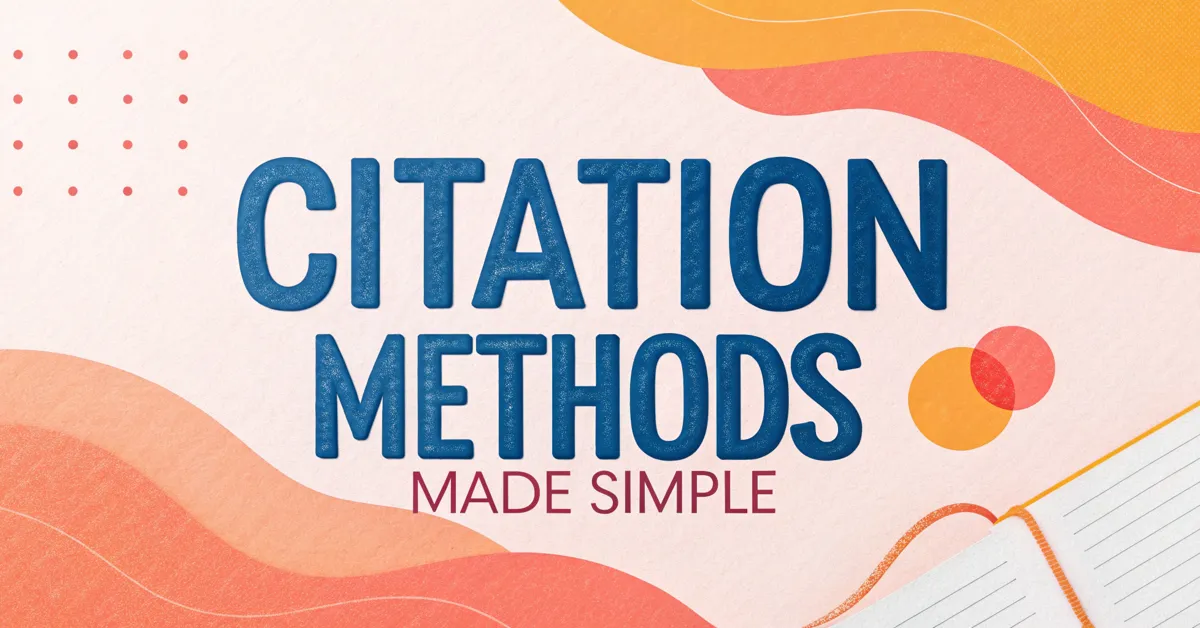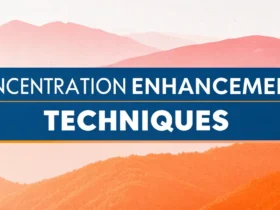Are you drowning in a sea of academic papers, feeling lost in the complex world of citations? Many students find citing sources a daunting task. They worry about getting it right, fearing plagiarism and struggling with the different citation styles. But don’t fret. Mastering citation methods doesn’t have to be a nightmare.
This article breaks down the core principles of citation format, offering clarity and practical guidance. We will explore the most popular citation styles, provide step-by-step instructions, and offer tips to simplify the process. You will learn why citations matter, how to choose the right style, and how to avoid common errors.
Think of this guide as your personal compass, leading you through the citation maze with confidence.
Citation Methods Made Simple
Why Citation Matters
Citations are more than just academic formalities; they are the backbone of scholarly integrity. Think of them as a way to give credit where it’s due and to build a strong, trustworthy argument.
Here’s why citation is crucial:
- Gives Credit: Citing sources acknowledges the work of others, preventing plagiarism. It’s a matter of intellectual honesty and respect for the original creators.
- Supports Your Argument: Citing reputable sources adds weight to your claims. It shows you’ve done your research and are building your argument on a solid foundation of evidence.
- Enhances Credibility: Well-cited work demonstrates your thoroughness and attention to detail. It signals to your readers that you’re a reliable and trustworthy researcher.
- Avoids Plagiarism: Properly citing sources helps you avoid unintentional plagiarism, which can have serious academic consequences.
- Allows Readers to Verify Information: Citations enable readers to locate your sources and verify the information you’ve presented. This transparency enhances the credibility of your work.
- Contributes to Scholarly Conversation: Citations connect your work to a broader body of knowledge. It allows you to engage with the ideas of others and contribute to the ongoing scholarly conversation.
In essence, citation format is about being a responsible and ethical scholar. It’s about respecting the work of others, building credible arguments, and participating in the academic community.
Choosing the Right Citation Style
The world of citation styles can seem overwhelming at first. There are several different styles, each with its own rules and conventions. How do you choose the right one for your paper?
The choice of citation style usually depends on the following:
- Subject or Discipline: Different academic disciplines often prefer specific citation styles. For example, MLA is common in humanities, APA in social sciences, and Chicago/Turabian in history.
- Instructor or Publication Guidelines: Your instructor or the publication you’re submitting to will usually specify the required citation style. Always follow their guidelines.
- Personal Preference: Once you’re familiar with several citation styles, you may develop a preference for one over another. However, always prioritize the requirements of your assignment or publication.
Here’s a brief overview of some of the most common citation styles:
- MLA (Modern Language Association): Commonly used in the humanities, particularly in language and literature studies. MLA emphasizes the author and page number in in-text citations and includes a “Works Cited” list at the end.
- APA (American Psychological Association): Widely used in the social sciences, such as psychology, education, and sociology. APA focuses on the author and year of publication in in-text citations and includes a “References” list.
- Chicago/Turabian: Used in a variety of disciplines, including history, art history, and religion. Chicago offers two main systems: notes and bibliography (preferred in humanities) and author-date (similar to APA).
- IEEE (Institute of Electrical and Electronics Engineers): Used in engineering, computer science, and other technical fields. IEEE uses a numbered citation system.
- AMA (American Medical Association): Used in medicine, health sciences, and related fields. AMA also uses a numbered citation system.
Consulting a style guide is essential. It provides detailed instructions and examples for formatting citations in various situations.
Here are some helpful resources:
- The MLA Handbook: The official guide for MLA style.
- Publication Manual of the American Psychological Association: The official guide for APA style.
- The Chicago Manual of Style: A comprehensive guide for Chicago style.
Core Elements of a Citation
Regardless of the specific citation style, certain core elements are common to most citations. These elements provide the essential information needed to identify and locate the original source.
The core elements typically include:
- Author: The name of the person or organization responsible for creating the work.
- Title: The name of the work being cited (e.g., book title, article title, website title).
- Source Title: The name of the larger work the source is part of (e.g., journal title, book title if it’s an essay collection, website name).
- Publication Date: The date the work was published.
- Publisher: The name of the company or organization that published the work.
- Location: Specific location information, such as page numbers (for print sources) or a URL (for online sources).
The order and format of these elements will vary depending on the citation style. Style guides offer specific templates and examples for citing different types of sources.
Mastering In-Text Citations
In-text citations are brief references within the body of your paper that point to the full citations in your bibliography or works cited list. They allow you to seamlessly integrate source material into your writing while giving proper credit.
The specific format of in-text citations varies depending on the citation style. However, the general principle is to provide enough information to clearly identify the source.
Here are some common types of in-text citations:
- Parenthetical Citations: Enclosing the citation information in parentheses within the text. Common in MLA, APA, and Chicago (author-date) styles.
- Note Citations: Using footnotes or endnotes to provide citation information. Common in Chicago (notes and bibliography) style.
- Numbered Citations: Assigning a number to each source and using that number in the text to refer to the full citation. Common in IEEE and AMA styles.
Direct Quotations
When using a direct quotation, you must reproduce the source text exactly, including punctuation and capitalization. Enclose the quotation in quotation marks and provide an in-text citation.
Here’s an example in MLA style:
“The only way to do great work is to love what you do” (Jobs).
Paraphrasing
Paraphrasing involves restating someone else’s ideas in your own words. Even when paraphrasing, you must cite the original source.
Here’s an example in APA style:
Studies show that intrinsic motivation is a key factor in achieving success (Jobs, 2005).
Summarizing
Summarizing involves condensing the main points of a source into a shorter form. As with paraphrasing, you must cite the original source.
Here’s an example in Chicago style (author-date):
Jobs (2005) argued that passion is essential for achieving excellence in any field.
Creating a Bibliography or Works Cited List
A bibliography or works cited list is a comprehensive list of all the sources you’ve cited in your paper. It appears at the end of your paper and provides full bibliographic information for each source.
The specific formatting of your bibliography or works cited list will depend on the citation style you’re using.
However, some general guidelines apply:
- Alphabetical Order: List your sources in alphabetical order by the author’s last name.
- Hanging Indent: Use a hanging indent, where the first line of each citation is flush with the left margin, and subsequent lines are indented.
- Double-Spacing: Double-space the entire list.
MLA Works Cited Example
Jobs, Steve. Stanford Commencement Address. Stanford University, 12 June 2005, news.stanford.edu/news/2005/june15/jobs-061505.html.
APA References Example
Jobs, S. (2005, June 12). Stanford commencement address. Stanford University. Retrieved from news.stanford.edu/news/2005/june15/jobs-061505.html
Chicago Bibliography Example
Jobs, Steve. “Stanford Commencement Address.” Stanford University, June 12, 2005. news.stanford.edu/news/2005/june15/jobs-061505.html.
Citation Generators: A Double-Edged Sword
Citation generators can be tempting shortcuts. They promise to create accurate citations with minimal effort. While these tools can be helpful, it’s essential to approach them with caution.
Pros:
- Time-Saving: Citation generators can quickly create citations, saving you time and effort.
- Convenience: They can be easily accessed online and often offer multiple citation styles.
- Helpful for Basic Citations: They can be useful for creating basic citations for common source types.
Cons:
- Accuracy Issues: Citation generators are not always accurate. They may make errors in formatting or omit important information.
- Lack of Nuance: They may struggle with complex or unusual source types.
- Over-Reliance: Relying solely on citation generators can prevent you from learning the rules and principles of citation.
Best Practices:
- Always Double-Check: Always carefully review and edit citations generated by these tools to ensure accuracy.
- Use as a Starting Point: Use citation generators as a starting point, but don’t rely on them blindly.
- Learn the Rules: Take the time to learn the basic rules of citation. This will help you identify and correct errors.
Think of citation generators as helpful assistants, but not as replacements for your own knowledge and critical thinking.
Tips for Simplifying the Citation Process
Citing sources can be a complex process, but there are several strategies you can use to simplify it.
Here are some helpful tips:
- Start Early: Don’t wait until the last minute to cite your sources. Start keeping track of your sources from the beginning of your research process.
- Use a Citation Management Tool: Citation management tools like Zotero, Mendeley, and EndNote can help you organize your sources and generate citations automatically.
- Create a Citation Template: Create a template for each type of source you’re using (e.g., book, article, website). This will help you ensure you include all the necessary information.
- Be Consistent: Choose a citation style and stick to it throughout your paper. Consistency is key to maintaining credibility.
- Keep Detailed Notes: When taking notes, be sure to record all the necessary citation information for each source.
- Consult a Style Guide: Keep a style guide handy and refer to it whenever you have questions.
- Ask for Help: If you’re struggling with citation, don’t hesitate to ask your instructor or a librarian for help.
- Proofread Carefully: Before submitting your paper, proofread your citations carefully to catch any errors.
- Understand the Purpose of Each Element: When you understand why each element is included, remembering the correct format becomes easier.
- Create a Cheat Sheet: Make a personalized cheat sheet for the citation style you’re using. This will serve as a quick reference guide.
By following these tips, you can make the citation process more manageable and less stressful.
Common Citation Errors to Avoid
Even with careful attention to detail, it’s easy to make mistakes when citing sources. Here are some common errors to watch out for:
- Missing Information: Omitting essential information, such as the author, title, publication date, or page numbers.
- Incorrect Formatting: Using the wrong format for in-text citations or bibliography entries.
- Inconsistent Style: Switching between different citation styles within the same paper.
- Failure to Cite: Not citing sources for direct quotations, paraphrases, or summaries.
- Plagiarism: Presenting someone else’s work as your own, whether intentionally or unintentionally.
- Incorrect Punctuation: Using incorrect punctuation in citations, such as commas, periods, or quotation marks.
- Misspelled Author Names: Misspelling the author’s name or other important information.
- Incorrect URLS: Providing incorrect or broken URLs for online sources.
- Missing Hanging Indents: Forgetting to use a hanging indent in your bibliography or works cited list.
By being aware of these common errors, you can take steps to avoid them. Proofread your citations carefully and consult a style guide to ensure accuracy.
The Future of Citation
The world of citation is constantly evolving, driven by technological advancements and changing scholarly practices. New tools and methods are emerging to simplify the citation process and enhance the discoverability of scholarly work.
Here are some trends to watch for:
- Increased Use of Citation Management Tools: Citation management tools are becoming increasingly popular among researchers and students. These tools streamline the citation process and make it easier to manage sources.
- Integration of Citation Tools with Writing Platforms: Citation tools are being integrated directly into writing platforms like Google Docs and Microsoft Word. This allows you to seamlessly cite sources as you write.
- Standardization of Citation Metadata: Efforts are underway to standardize citation metadata, making it easier to exchange and reuse citation information across different platforms and systems.
- AI-Powered Citation Assistance: Artificial intelligence (AI) is being used to develop tools that can automatically identify and cite sources in academic papers.
- Emphasis on Open Access and Data Citation: There’s a growing emphasis on citing open access resources and research data. This promotes transparency and reproducibility in scholarly work.
- Blockchain Technology: Blockchain tech is also being explored to verify and track the ownership and use of scholarly works.
While these advancements promise to simplify citation and improve the quality of scholarly communication, it’s important to remain grounded in the core principles of citation: giving credit, supporting arguments, and avoiding plagiarism.
So, Should You Stress About Citations?
Citations are an integral part of academic work. They serve as a framework for intellectual honesty and credibility. While the citation process can seem intricate, understanding its core principles can transform it from a daunting task to a manageable and even empowering skill.
With the right knowledge and approach, you can confidently navigate the citation maze and produce high-quality, well-supported academic work.
So, instead of stressing about citation format, embrace it as an opportunity to showcase your research skills and contribute to the scholarly conversation.















Leave a Reply
View Comments